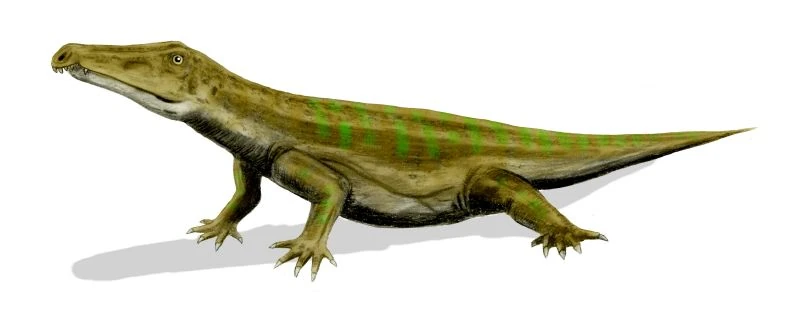 Proterosuchus is an extinct genus of Early Triassic proterosuchid archosaur. Remains have been found from South Africa and China. The genus Chasmatosaurus is considered a junior synonym of Proterosuchus, as all species of Chasmatosaurus, including C. aleandri, C. vanhoepeni, and C. yuani, have been reassigned to Proterosuchus. Elaphrosuchus has also been synonymized with Proterosuchus. The type species of Proterosuchus is P. fergusi. Two other species, P. ultimus and P. yuani, have also been named.
Proterosuchus is an extinct genus of Early Triassic proterosuchid archosaur. Remains have been found from South Africa and China. The genus Chasmatosaurus is considered a junior synonym of Proterosuchus, as all species of Chasmatosaurus, including C. aleandri, C. vanhoepeni, and C. yuani, have been reassigned to Proterosuchus. Elaphrosuchus has also been synonymized with Proterosuchus. The type species of Proterosuchus is P. fergusi. Two other species, P. ultimus and P. yuani, have also been named.
Description[]
Proterosuchus was the largest land reptile during the Early Triassic period, equivalent in size to today's Komodo Dragons. It looked somewhat similar to a primitive crocodile, and shared many of their modern features like long jaws, powerful neck muscles, short legs and a lengthy tail, while retaining several of its own unique features such as its long legs, and hooked shaped mouth. This jaw made it near impossible for prey such as Lystrosaurus to escape death once ensnared. Proterosuchus, like most modern crocodiles, was an ambush predator, waiting for its prey to enter the water, at which point they would be attacked from below the surface, using the long, muscular tail for swimming and pushing through the water at speed. However, the animal also had stout legs that enabled it to walk comfortably at land. Being able to move between the land and the water was a great advantage, and enabled Proterosuchus to control its body temperature by sunbathing or cooling off in the water. Being an ambush predator, like some present-day crocodiles meant that for the most part Proterosuchus remained in one environment for most of its life. This worked as an excellent means of conserving energy, even giving it the capability of surviving for perhaps months at a time without food.
Although it could live and swim in the water, Proterosuchus preferred to hunt land animals rather than fish. Its eyes were located on the top of its head, allowing it to hide just under the surface of the water, where it would wait for animals to come and drink. When close enough, Proterosuchus would spring upwards and drag its victim into the water, drowning and then eating it.
Proterosuchus is an example of an early archosaur, the group which encompasses crocodiles, pterosaurs, dinosaurs, and birds. It has was once believed to have been an ancestor to the crocodilians, but it is now known to be far more basal.
Comparisons between the scleral rings of Proterosuchus and modern birds and reptiles indicates that it may have been cathemeral, active throughout the day during short intervals, supporting the idea that early archosaurs adapted to dim light. However, as Proterosuchus may have been a polar animal, it likely lived under different lighting conditions from typical archosaurs and may not have inherited such adaptations from a common ancestor with archosaurs.
Species[]
The type species of Proterosuchus is P. fergusi, named by Robert Broom in 1903 from Tarkastad, Eastern Cape in South Africa.[2] It has been found from the Lystrosaurus Assemblage Zone of the Beaufort Group in the Karoo. Several other species of proterosuchids have been described from the Karoo, including Chasmatosaurus vanhoepeni in 1924,[3] Elaphrosuchus rubidgei in 1946,[4] and Chasmatosaurus alexandri in 1965.[5] These species were distinguishable from one another on the basis of size-related characteristics. More recently, these characteristics have been considered to represent different stages in the growth series of one species.[6] Because the name Proterosuchus fergusi has seniority, the other species have been synonymized with P. fergusi.
A new species of Chasmatosaurus, C. yuani, was described from Xinjiang, China in 1936. It has been found from the Cangfanggou Group near Jimsar, northeast of Ürümqi.[7] It was reassigned as a new species of Proterosuchus in 1970.
Classification[]
References[]
- Haines, Tim, and Paul Chambers. The Complete Guide to Prehistoric Life. Pg. 58. Canada: Firefly Books Ltd., 2006